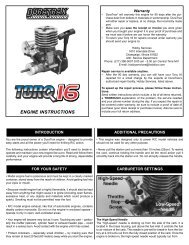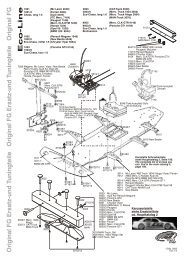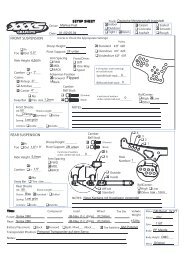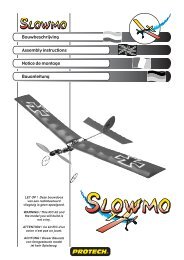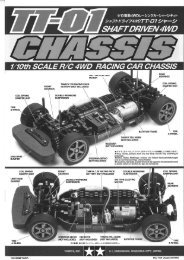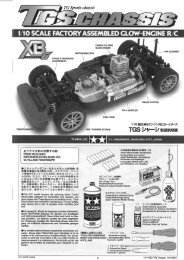Robbe Cardinal.pdf - RCtube.eu
Robbe Cardinal.pdf - RCtube.eu
Robbe Cardinal.pdf - RCtube.eu
You also want an ePaper? Increase the reach of your titles
YUMPU automatically turns print PDFs into web optimized ePapers that Google loves.
Bild 45<br />
- Zur Festlegung der Akkuposition muß das Modell jetzt<br />
ausgewogen werden.<br />
- Den Flugakku 6.11 in den Akkuschacht klemmen, nicht<br />
anschließen.<br />
- Luftschraube 6.12 aufschieben, noch nicht befestigen.<br />
Bilder 46 und 47, Auswiegen<br />
- Das Schwerpunktzeichen C.G. (Dekor) beidseitig<br />
anbringen.<br />
- Tragfläche mit der Tragflächenschraube 6.13 aufschrauben.<br />
- Das Modell im Schwerpunkt unterstützen und auspendeln<br />
lassen. Die Idealstellung ist erreicht, wenn das<br />
Modell mit leicht nach unten hängendem Vorderteil in<br />
der Waage bleibt.<br />
- Flugakku falls erforderlich entsprechend verschieben.<br />
Zur Sicherung des Akkus in der gefundenen Position die<br />
Leiste 6.14 auf den Akkudeckel 6.8 kleben.<br />
- Erst, wenn das Trimmen mit dem Akku nicht ausreicht,<br />
Trimmblei verwenden, welches entsprechend im<br />
Rumpfheck bzw. in der Rumpfnase platziert wird. Schlitz<br />
einschneiden, Trimmblei eindrücken und bei korrekter<br />
Schwerpunktlage mit Epoxy fixieren.<br />
Funktionsprobe<br />
Bild 48<br />
- Die Fernst<strong>eu</strong>erung betriebsbereit anschließen. Erst den<br />
Sender einschalten. Der Gasknüppel muß sich in der<br />
Stellung „Motor Aus“ befinden. Den Flugakku 6.11 einlegen<br />
und anschließen.<br />
- Den Regler gemäß der Anleitung, die dem Gerät beiliegt,<br />
einstellen. Nach erfolgter Einstellung darf der<br />
Motor jetzt nicht anlaufen.<br />
- Gas geben, Motorlaufrichtung prüfen. Der Motor muß<br />
von vorn gesehen gegen den Uhrzeigersinn drehen.<br />
Bauanleitung, Assembly instructions, Notice de montage<br />
<strong>Cardinal</strong><br />
Fig. 45<br />
- The model must now be balanced in order to determine<br />
the correct battery position.<br />
- Push the flight battery 6.11 into the battery well, but do<br />
not connect it at this stage.<br />
- Fit the propeller 6.12 on the motor, but do not tighten the<br />
retaining screws.<br />
Figs. 46 and 47, balancing<br />
- Mark the Centre of Gravity (C.G. - decal) on both sides<br />
of the fuselage.<br />
- Fix the wing to the fuselage using the wing retainer<br />
screw 6.13.<br />
- Support the model at the marked points and allow it to<br />
hang freely. Ideally the model will balance level, with the<br />
nose inclined slightly down.<br />
- If necessary adjust the position of the flight battery<br />
slightly until the model balances correctly. Glue the strip<br />
6.14 to the battery hatch 6.8 to secure the battery in the<br />
position you have established.<br />
- Lead ballast may be used to achieve correct balance,<br />
but only if re-positioning the battery is not sufficient. The<br />
lead should be fitted in the extreme tail or nose of the<br />
fuselage. Cut a slot, press the lead into it, then check<br />
the CG again. When correct, epoxy the ballast in the<br />
slot.<br />
Checking the working systems<br />
Fig. 48<br />
- Connect the components of the radio control system.<br />
Switch on the transmitter first, and check that the throttle<br />
stick is at the „motor stopped“ position. Place the flight<br />
battery 6.11 in the fuselage and connect it.<br />
- Set up the speed controller in accordance with the<br />
instructions supplied with the unit. When the controller is<br />
correctly adjusted, there should be no tendency for the<br />
motor to start running when the stick is at the OFF position.<br />
- Open the throttle gently, and check the direction of rotation<br />
of the motor. The motor shaft must rotate anti-clockwise<br />
when viewed from the front.<br />
25<br />
Fig. 45<br />
No.<br />
3026<br />
- Pour déterminer la position de l’accu, il faut maintenant<br />
équilibrer le modèle.<br />
- Coincer l‘accu d’alimentation du mot<strong>eu</strong>r 6.11 dans le<br />
logement de l‘accu, ne pas le raccorder.<br />
- Mettre l’hélice en place 6.12 sans la fixer pour l‘instant.<br />
Fig. 46 et 47, Équilibrage<br />
- Appliquer les éléments de décoration du centre de gravité<br />
C.G. de chaque côté.<br />
- Fixer l‘aile à l’aide de la vis d’aile 6.13.<br />
- Caler le modèle au niveau de son centre de gravité et le<br />
laisser en équilibre. Il présente une position idéale lorsqu’il<br />
dem<strong>eu</strong>re en équilibre avec le nez légèrement incliné<br />
vers le bas.<br />
- Si nécessaire, décaler l‘accu d’alimentation du mot<strong>eu</strong>r<br />
en conséquence.<br />
- Pour fixer dans la position d’équilibre, coller la baguette<br />
6.14 sur le couvercle d’accu 6.8.<br />
- Ce n’est que lorsque l’équilibrage avec l’accu s’avère<br />
inefficace qu’il faut envisager la mise en place de plomb<br />
de lestage qui sera planté dans des encoches entaillées<br />
dans le nez ou dans la qu<strong>eu</strong>e du modèle avant d’y être<br />
collé à la colle époxy lorsque la position du centre de<br />
gravité est correcte.<br />
Essai de fonctionnement<br />
Fig. 48<br />
- Raccorder l’ensemble de radiocommande de manière<br />
qu’elle soit en ordre de marche. Mettre d’abord l’émett<strong>eu</strong>r<br />
en marche. Le manche des gaz doit se trouver en<br />
position „mot<strong>eu</strong>r coupé“. Mettre l‘accu d’alimentation du<br />
mot<strong>eu</strong>r 6.11 en place et le raccorder.<br />
- Régler le variat<strong>eu</strong>r en fonction des indications fournies<br />
par la notice accompagnant l‘appareil. Une fois que le<br />
réglage a été établi, il ne faut pas que le mot<strong>eu</strong>r démarre<br />
pour l‘instant.<br />
- Donner des gaz, contrôler le sens de rotation du mot<strong>eu</strong>r.<br />
Le mot<strong>eu</strong>r doit, vu de l’avant, tourner dans le sens contraire<br />
des aiguilles d’une montre.



